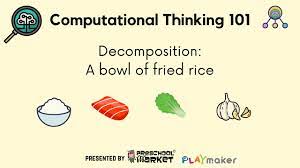
Ingredients for fried rice to illustrate computational thinking decomposition
Contents
Module Objectives:
In this module you will:
- Understand how decomposition supports computational thinking
- Identify decomposition activities to use in your classroom
- Practice decomposition
Activity #1: What is Decomposition?
Read Deitz et al., (2019)
Dietz_Landay_Gweon_2019-Read Rich et al., (2019)
Rich-et-al-2019Read: Learning.com Why is Decomposition Required in Computational Thinking?
https://www.learning.com/blog/why-is-decomposition-required-in-computational-thinking/
Read Brooks (2019)
Watch: Computational Thinking: Decomposition
Review: REMC Association of Michigan Decomposition
https://www.remc.org/21Things4Students/21/21-computational-thinking/q2-decomposition/
Review: Teaching London Computing Decomposition
Read: ISTE Understanding Problems with Computational Thinking Decompostion
Activity #2: Create a SIMPLE Rube Goldberg Machine
Review these resources
How Should I Start?
Before you start building a Rube Goldberg machine, you need a task for it to accomplish. What simple action should your machine do? Here are some examples:
- Put a ball into a bucket
- Turn off a light
- Pop a balloon
- Water a planet
- Put toothpaste on a toothbrush
None of these ideas appeal to you? No worries, come up with something, just make sure it’s a simple task.
Rube Goldberg Machine Materials List
It doesn’t matter what you use to build your Rube Goldberg Machine. All that matters is you get creative and have fun. Here is a Rube Goldberg Machine materials list. I’ve used all of these items when creating Rube Goldberg Machines in the past.
You do not need all these things! Just search around the house for things you have and think up creative ways to use them.
- Dominos
- Action figures
- String
- Tape
- Recyclable Materials (paper towel tubes, paper bags, milk jugs, etc.)
- Buckets
- Marbles
- Legos (of any size)
- Balls (tennis ball, basketball, baseball, etc.)
- Pot and Pans
- Boxes
- Cups
- Tinker toys
- Erector sets
- Board games
- Matchbox Cars
There are other things around your house that you’ll find during your search for materials too.
Get creative! There is no such thing as a Rube Goldberg Machine that is too big or too small!
Building Your Rube Goldberg Machine
Now that you’ve gathered all your materials together and picked a task it’s time to start building.
Grab a piece of paper and a pencil and sketch out what you want your machine to look like. The building will go easier, and more smoothly, this way.
With a sketch completed, start from the end and work towards the beginning. That way you know your spacing will work.
A word of caution when using dominos, add them last. Getting them all in place and having them fall because what you were building next to it fell apart or some other mishap happened, is the WORST!
Documenting your Effort
- Share your sketch.
- Take pictures as you build your Rube Goldberg Machine.
- Record a video of your machine in operation.
- Post your photos and video on this Google Doc https://docs.google.com/document/d/1OUYKLyWR2yxoUBKKH7dOyOz5coM0y3lf0FHTh1MoCOs/edit?usp=sharing